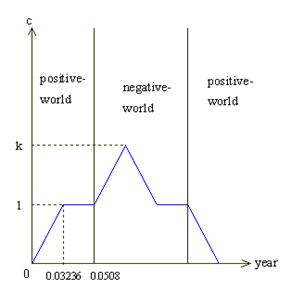This is the latest version.
Chapter 3: Galaxy traveling
 |
 |
||
 |
 |
@Suppose you have new engines. They are completely new revolutionary engines which make flights of long term with constant big driving force in deep space possible. Suppose you build a star ship of which total weight "M" is 10,000 tons including cargos to secure space and strength enough to travel among stars. As there is not much influence over human bodies by acceleration if keeping constant driving force after increasing driving force gradually, you can suppose the spaceship can emit 30g driving force by the new engines.
As assumption of following calculations, the relation between lightyear and meter are shown. As one lightyear is a distance where light of 1c advances for a year, y30z is available.
|
|
|
|
|
|
|
|
|
|
Time which this starship needs to rush into Minus-world is asked. Since gimpulse = force ~ timeh, time is asked by dividing impulse by force. In this case, impulse is ÎMc/2, and force is M~30g. Then, time is calculated like y31z, and it is 0.0508year.
Time to reach the speed of light by acceleration 30g is asked. Since gspeed = acceleration ~ timeh, time is asked by dividing speed by acceleration. In this case, speed is c, and acceleration is 30g. Then, time is 0.03236year.
This time is shorter than the time to rush into Minus-world. After the spaceship reaches to speed c by 0.03236year, it experiences the condition of foot dragging till it receives impulse needed to rush into Minus-world. And, as soon as the impulse reaches ÎMc/2, the spaceship rushes into Minus-world. Like this, I think, when it returns from Minus-world to Plus-world, it experiences the same condition of foot dragging in Minus-world.
|
|
|
@Suppose a starship of 10000tons which can easily emit force of 30g travels from the Earth to another star system. It accelerates from 0 to kc. As soon as its speed reaches to kc, it begins to deaccelerate. It accelerates with 30g until the speed becomes kc from 0. It deaccelerates with 30g until the speed becomes 0 from kc.
On the assumption of above, relation between time and speed of the starship is shown in Figure 6. This Figure 6 has a symmetrical mountain
Needed time and distance which can be reached are asked on the assumption of above. Since gdistance = speed ~ timeh, I calculate the area of the symmetrical mountain. For the convenience of the calculation, the mountain of Figure 6 is divided into six parts from (a) to (f) like Figure7. (b) and (e) are the conditions of foot dragging with speed of 1c.
First, needed time is asked.
Time of (a)+(c) is asked. As they have same acceleration of 30g, (a)+(c) is considered as one triangle. When the time is asked by dividing speed kc by acceleration 30g, y33z is available. Then, when the value of gc/30gS h of y32z is substituted for y33z, it becomes 0.03236k like y34z.
Time of (b) is asked. Since time of (b) is a period from time to reach to 1c to time to rush into Minus-world, the time of (b) is y35z by pulling time of y32z from time of y31z.
Time from speed 0 to kc is y36z by adding y35z to y34z. As (a)(b)(c) and (d)(e)(f) are symmetrical, time from the Earth to the other star system is y37z twice y36z.
|
|
|
|
|
|
Then, how far by lightyears is the star system that you can reach? It is asked by the area of the mountain in Figure 6.
Area of (a)+(c) is asked. As they have same acceleration of 30g, (a)+(c) is considered as one triangle. From y34z, time of (a)+(c) is 0.03236k(year). Speed to reach is kc. The area of triangle (a)+(c) is y41z.
Rectangular area of (b) is asked. From y35z, time is 0.01844year. Since they fly with 1c, the rectangular area is y42z.
Since the mountain in Figure 6 is symmetrical, the whole area of the mountain is twice the total of the area of (a)+(c) y41z and the area of (b) y42z. After all, the distance to the other star system is y43z.
|
|
|
|
|
|
@I ask necessary time to go from the Earth to the Centaurus ¿ 4.3 light-years away. Solving y45z, y46z is available.
|
|
|
|
|
|
@Substituting y46z for y37z, you can get an answer, about 0.78 year. You can go to and return from the Centaurus ¿ in 2 years in the spaceship time.
Also, in the Earth time, the converse of Urashima Effect occurs during super lightspeed flights in Minus-world according to y3z like Figure 5, you can go and return earlier than 2 years.
Then, according to y2z, like Figure 4, during super lightspeed flight in Minus-world, the mass decreased but I ignored its influence.
With the new engine which can give constant big force, I showed that super lightspeed flights become possible. I built this theory in the direction which gave this possibility and an anxiety from this remains. I think rushing into Minus-world in Îmc/2 is sure. But is it possible to return surely from Minus-world? However, I think return from Minus-world is easier than rush into Minus-world. Because you can think returning to the world where gravitation acts on from the world where the repulsion acts on is easier than rushing into the world where repulsion acts on from the world where gravitation acts on.
I wish a door to the Era of Space Grand Navigation would be opened when we have more discussions about Minus-world in the future and it becomes theoretically sure that return from Minus-world is easy.





